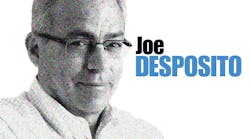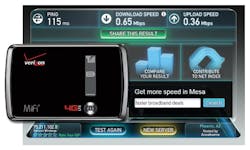CES Proves That 4G LTE Still Has A Long Way To Go
There’s probably no better proving ground for 4G technologies than the International CES in Las Vegas. The show drew more than 150,000 in January, essentially bringing 4G to its knees.
I had brought a Verizon Jetpack 4G LTE mobile hotspot (MiFi 4510L) to the show, hoping to transfer some large video files while I was there. My first attempt to transfer a 500-Mbyte file came to naught when I noticed that only the violet LED on the device was blinking.
This meant that only 3G service was available. Throughout my entire stay at the show, I never saw the green light blink, indicating that Verizon’s 4G LTE service was available.
A speed test of upload and download speed confirmed that Verizon’s 4G LTE hotspot was operating at 3G speeds during CES.
One thing that surprised me at the show, as I spoke with executives from many high-tech companies, was their complete resignation to the fact that fast wireless service was not available. No one was particularly aggravated with the situation. It was more of a “what can you do?” attitude. This surprised me since I was really disappointed that my 4G hotspot wasn’t working as it should.
I ran a speed test on speedtest.net and got just 0.65 Mbits/s for the download speed and 0.36 Mbits/s for the upload speed (see the figure). That’s excruciatingly slow. I don’t know for sure if any other 4G systems were operational, such as WiMax from Sprint, but I assume that they too were struggling to accommodate the crowd. If anyone has a service other than Verizon’s, I’d like to hear about your experience with 4G at CES.
Global LTE Subscribers Set To Double
A recent IHS iSuppli report said that global LTE subscribers will more than double in 2013, exceeding 100 million. By 2016, IHS says that LTE will claim more than 1 billion users, equivalent to a five-year compound annual growth rate of 139%.
Related Articles
• Millimeter Waves Will Expand The Wireless Future
• Ethernet Rules Networking—And It’s Still Growing
• Interview: NYU Wireless Director Addresses Millimeter Waves
This is excellent news for carriers, who can charge significantly more for 4G services than they did for 3G. And apparently, they have no obligation to actually provide the service if the traffic is too congested. That’s a win-win for the carriers and a lose-lose for consumers under certain circumstances.
I paid $90 for the month for 10 Gbytes of mobile broadband data. I chose that plan due to my own plans to transfer a bunch of large video files over the network to our Engineering TV crew. But I hardly used any of it.
Would Verizon refund my money or extend my service since I couldn’t use the LTE data service for a week? A call to customer care informed me that 4G isn’t guaranteed in some areas, even though it looked solid on the map that Verizon provides on its Web site (search VZW Map at verizonwireless.com). Plus, the representative said, I called after my one-month plan had expired, so Verizon couldn’t do anything for me. Very convenient.
I actually love Verizon’s LTE—when it’s working. After CES, I used the hotspot to connect to the Internet while on the railroad travelling home from my office in Manhattan. It worked perfectly, allowing me to view large attachments on e-mail and catch some of the video we shot at CES (see engineeringtv.com).
Qualcomm’s Plan for LTE and Beyond
Several months ago I listened to a talk by Matt Grob, CTO of Qualcomm, at MIT’s Emerging Technology Conference. The gist of the talk concerned how to meet the growing network capacity needs of mobile users—1 billion by 2016, as noted above. He outlined a very aggressive plan to increase capacity by 1000 times! There were several facets to the plan, which he explained eloquently during his talk.
Part of the plan involved a great expansion of small-cell basestations. Particularly impressive was the fact that he posited a new paradigm, where small basestations inside of buildings would also provide coverage outside, instead of the other way around—that is, large outdoor basestations providing all of the coverage. You can view the video in its entirety at http://bit.ly/10S78BU. I sure hope the plan is successful.

